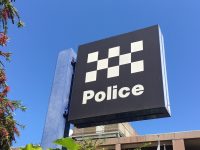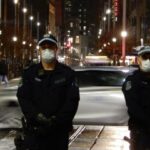Gold Coast Cops No Longer Allowed to Patrol in Groups

For many years, officers patrolled Surfers Paradise on the Gold Coast in groups of four or more, but a new ‘anti-violence initiative’ means many are now walking the beat in pairs.
The move has officers claiming they are fearful for their safety, despite being armed with an artillery of lethal and non-lethal weaponry.
Duos will be more ‘approachable’
Assistant Police Commissioner Brian Codd says the ‘duo trial’ aims to find a balance between making officers more approachable and maintaining officer safety.
By splitting teams into two, the Service also aims to create greater mobility and better coverage, whilst still being able to unite quickly should the need arise.
In New South Wales, police normally patrol in pairs, and splitting-up while on duty can amount to a breach of protocol.
Safety at risk?
Many Gold Coast officers have expressed concerns over the new arrangement, not just for their own safety, but for that of the general public.
One officer told the local media that group patrols demonstrate a vigilant and strong police presence, which deters anti-social behaviour and maintains safety for tourists and locals.
The officer claims that without a heavy presence, Surfers Paradise could go back to the ‘way it was’.
However, the contrary view is that large groups of heavily armed police can lead to an ‘us versus them’ mentality, creating friction and increasing the likelihood of violent confrontations. Indeed, Queensland police have repeatedly come under fire in recent times for using excessive force in numbers against members of the public.
And it appears the Queensland Police Union may agree, conceding the initiative appears to be working:
“assaults against police have reduced, complaints against police have reduced and more groups of police in smaller numbers has led to more area being covered”, a Union spokesperson said.
The Union also acknowledges the scheme has potential to change perceptions of police on the beat: “…Police appear less confrontational, less aggressive… yet continue to maintain a safe, authoritative and commanding presence.”
Just a PR move?
While the Queensland Police Service says ‘policing in pairs’ is strictly an anti-violence initiative, many believe it is an attempt to restore the organisation’s shattered public image.
Officers stationed at the Gold Coast have been the subject of internal police reviews for numerous cases of brutality, including assaults upon Brayden Aaron Mechen, Michael Cox, Natasha King, John Beard, Paul Tupu-Folasa and Noa Begic.
In September 2015, a senior internal police investigator was appointed to delve into the culture of police violence in the sunshine state, particularly the south-eastern corner. Around the same time, a proposal was put forward calling for all officers to wear body cameras – a move ostensibly aimed at promoting transparency and accountability; although those ideals are undermined by the fact that officers can turn the cameras on and off as they please.
With the spread of camera phones and CCTV, combined with the ability to instantly distribute information through social media, fresh evidence of police brutality and other forms of misconduct is available for all to see on an almost-daily basis, and officers who lie and attempt to cover-up their own actions or those of their colleagues are more likely to be caught, although they are rarely disciplined or prosecuted.
That said, Queensland’s initiative is a step in the right direction when it comes to restoring faith in the police service – although there is still a long, long way to go.






